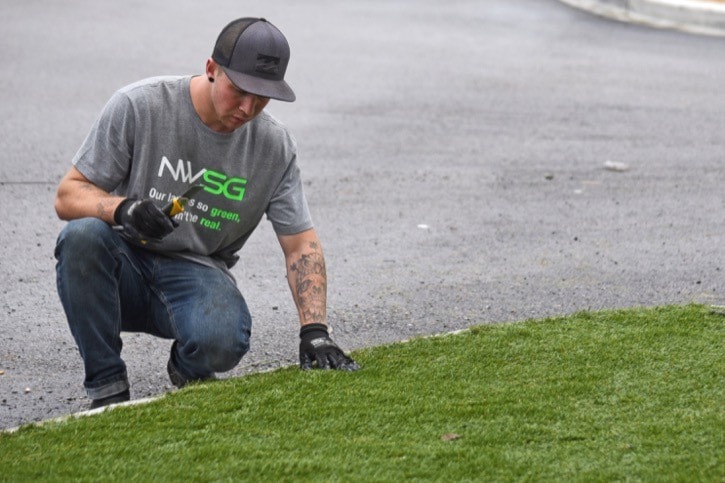After a record-dry summer in 2015, and water restrictions starting two weeks earlier this year, more and more homeowners are turning to greener solution to keep their lawns from turning brown.
Synthetic grass, a polyurethane material made to look and feel like the real deal, is quickly becoming a trendy alternative in the Lower Mainland.
Since beginning his synthetic grass company one year ago, Allen Hewitt, owner of North Western Property Maintenance and North Western Synthetic Grass in Langley, has seen his business “explode,” having to work up to 15 hours a day to keep up with demand.
“About a year ago, I was literally walking with my dog and I was thinking that we need a product that better serves Langley’s new homes,” said Hewitt, a Langley Secondary School graduate.
“Because new homes are being built on small lots with larger houses and smaller backyards. And it didn’t make any sense to me that we were putting grass down, because now the homeowner needs to buy a lawn mower to literally cut 200 square-feet of grass.
“And then last year, with the water restrictions, and everyone’s lawns turning yellow, I started to think ‘OK what should we be tackling next? What product should we be bringing in there?’ And so I came across synthetic grass and right away I knew that was it.”
Synthetic grass installation now accounts for 80 per cent of his work, with the other 20 per cent in maintenance for mainly commercial and strata properties through North Western Property Maintenance, a company he started five years ago.
The same trend holds true for Bobby Nijjer of FG Lawns, who says his synthetic grass orders have increased by 200 per cent in the last two years.
“We’re booked up for another month and a bit. It’s pretty crazy,” Nijjer said.
“People didn’t know much about it (synthetic grass) when I first started in 2010. And then as we did home shows, and advertising, people got to know more about the product and got to know more about how beneficial it is.”
Scott McCartney has been operating Precision Greens in South Surrey and South Langley for 17 years, and has never seen it so busy.
His synthetic grass sales have also jumped by 200 per cent in the last year, which he attributes to dryer weather conditions and the chafer beetle, an invasive insect that has desecrated lawns on the northern side of the Fraser River.
“It’s grown every year. We were the first synthetic turf company to market in the area and it started out very small, it was a hard sell,” McCartney said.
“The trend started in more drought prone states (like) Nevada and California, and so their technology really started to evolve … as the turf market down south took off we piggy backed off that because we had access to those technologies.”
McCartney says they began with synthetic golf greens in 2000 and slowly began installations at residential homes as well. But since 2012, residential demand has doubled every year.
“2015, 2016 have just been bananas,” he said.
“Most people understand the product, they are familiar with it, and they know the longevity is there, they know it looks good … it’s really taken off.”
There are now dozens of different high-quality synthetic grasses on the market, with most lasting anywhere from 15 to 20 years.
Hewitt says the products he purchases from the United States are tested to the same standards as a baby soother, are made with anti-mold and anti-bacterial properties and are recyclable when they reach the end of their lifespan. He’s even had clients tell him they act as mosquito repellent, as the water does not sit on top of the grass.
And as for pets? The filtration system is designed to accommodate pet waste, leaving behind no unwanted odour.
“Another great benefit of synthetic grass is the environmental impact,” Hewitt said.
“It’s pretty ridiculous that we water our lawns right now with cleaner drinking water than what the majority of the world has. With a product like this, you don’t water your grass. You don’t use a lawn mower that pollutes.”
At a cost of about $10 to $14 per square foot, Hewitt estimates the fake grass pays for itself within three to four years, if the homeowner currently hires someone to mow their lawn.
Corbin Chivers, a local real estate agent who recently had synthetic grass installed in his own yard on 72 Avenue, says it can even add property value to a home.
“I do not have to worry about cutting it (the grass) and it seems like such a waste to use water on it,” he said. “The relative cost of installation versus the increase in value is a no brainer.”
Even at the municipal level, the Township has installed artificial turf playing fields at several parks, including Aldergrove Athletic Park, McLeod Athletic Park and Willoughby Community Park.
Despite the many benefits, there are still hazards associated with replacing nature with plastic. On a hot summer’s day, the temperature on artificial turf can be as much as 20 degrees higher than even asphalt. This was seen last year at the Women’s World Cup in Edmonton, where Team Canada and Team China played on a turf that was 49 degrees, when the air temperature was only 23 degrees.
There are also many concerns with “crumb rubber,” a material made of recycled rubber often used as infill to hold the grass down on sports fields, which numerous studies have shown contains cancer-causing materials. This product is generally used only on sports field, as the rubber also works as a cushion for running athletes.
